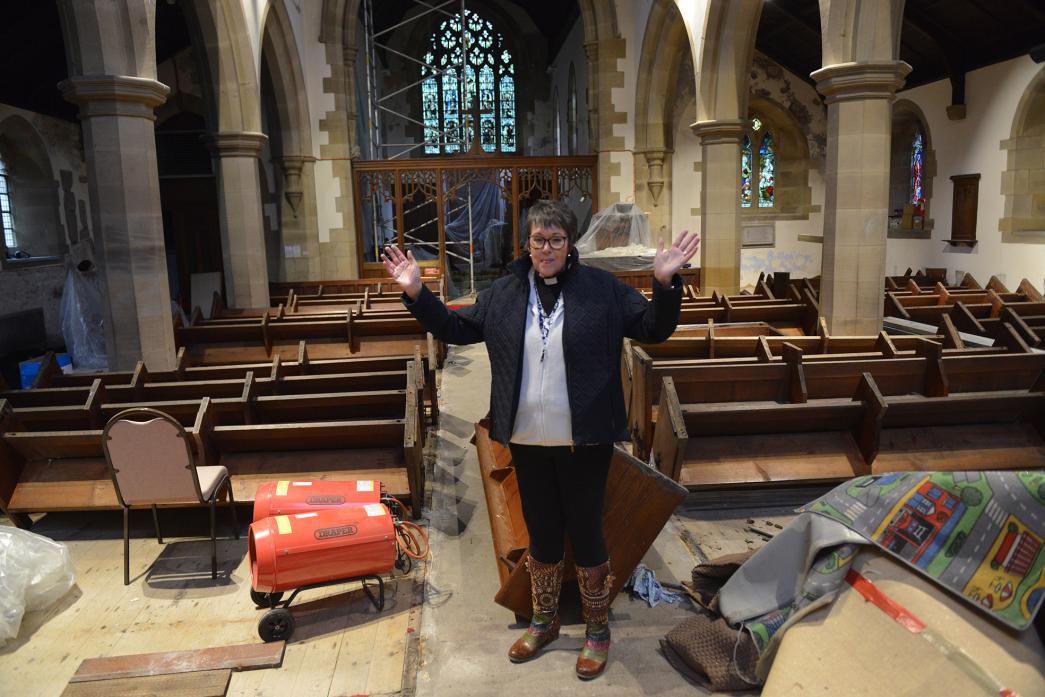
TRANSFORMING into the upper dale’s culture and heritage hub may just be the answer to a prayer to save a church on the brink of closure.
Middleton-in-Teesdale’s 142-year-old St Mary’s Church has recovered from one ageing mishap to the next in recent years, with its roof and guttering having to be replaced, and extensive repointing needing doing.
Damp that had got into the walls had to be repaired and re-plastered. New lighting had to be installed.
And after spending many thousands of pounds, parishioners thought they had future-proofed their church for the next 100 years.
But last summer, while plastering, dry-rot was discovered – the entire floor would have to be pulled up and replaced.
Vicar Revd Alison Wallbank said: “We discovered it last June. When they removed the back pew to put up some scaffolding, they realised the wood was rotten.”
Inspection chambers opened across the church showed it had spread from the rear of the church all the way up to the organ. Half a dozen pews were also affected.
Ms Wallbank said: “They have to be burned or disposed of.”
The church has been closed since the discovery and the congregation has had travel to services at Forest-in-Teesdale and Eggleston.
Despite receiving £20,000 from county councillors Richard Bell and Ted Henderson’s neighbourhood budgets to remove the floor, there was no cash and little hope of getting more funding to replace it. All seemed hopeless.
However, a fellow priest’s vision of churches being places to celebrate culture sparked an idea.
Ms Wallbank said: “I read her suggestions and I just felt compelled to agree with her, because yeah, what a beautiful building when put right, but it is not on the tourist map.
“Upper Teesdale to our knowledge doesn’t have a heritage and culture centre. It has a visitor centre at Bowlees, but that is interested in the flora and the fauna and that kind of thing.
“There is nothing to celebrate the lead mining. Middleton-in-Teesdale became the head of the London Lead Mining Company – all the bigwigs had beautiful houses built here. It was the lead mining during the Victorian times that gifted the pulpit and many of the things the church has.”
Famous lead mining poet Richard Watson is buried in the churchyard and one of the stained-glass windows is dedicated to him.
Mrs Wallbank said: “In Teesdale there are many heritage groups that don’t have a space to exhibit their archives and some of them would relish the opportunity to have a big space to put on events and exhibitions.
“With this vision we could put together a programme with a whole list of events during the summer tourist season. Cultural groups could book the space to put on photographic exhibitions.
“We have definitely got fantastic lighting, which we haven’t yet used, and this church is almost acoustically perfect, so it could be used as a concert venue as well. The reason we thought culture and heritage is because lots of local artists would love to have an exhibition here. So, putting in the word culture opens it up a bit.”
Most importantly, the addition of the culture and heritage centre to the church will allow it to access funding that it otherwise not be able to. This would not only cover the cost of putting in a new floor, but also allow the introduction of such features as underfloor heating.
If successful, the idea is for all the pews to be removed from the church and replaced with loose chairs which can be taken away for exhibitions and re-arranged for church services, weddings, concerts and other activities. During the summer months, when the programme of cultural and heritage activities is busiest, the congregation would hold services at the nearby Methodist church and return to St Mary’s during the off-season.
Ms Wallbank said: “What gets me excited is that it is a way to keep the church going for the benefit not just of the village, but of all the visitors that come to Teesdale.
“And tourism is quite high on the people’s agenda because we have lost a year [due to Covid-19]. It is another reason to come to Middleton, not just to pass through on the way to High Force.”
Heritage and cultural groups have already expressed an interest, including the Fitzhugh Library which has an extensive collection of books and artefacts relevant to the area.
Now the vicar is appealing to more heritage and culture groups, schools and any other organisations that might omit want to host events and activities in the church to get in touch so that a dossier of expressions of interest can be compiled for funding bids.
Ultimately, the dry-rot which might have been the death knell of the Victorian church that was built on the foundations of an older medieval one, might well be its saving grace.
Mr Wallbank said: “It is almost like new life. The congregation is dwindling, and is ageing, so we need new blood and new life. We have been praying for new life every Friday morning since I came here and we always pray for the life of this church, asking God, ‘what do you want us to do with this beautiful place that is going to die?’.
“Our prayers have been answered with this vision.”
Any groups that want to be part of the church’s transformation and would like to submit an expression of interest can contact the vicar by email at alisonwallbank59@gmail.com.





